![[Previous]](../../../buttons/fprev.png)
![[Next]](../../../buttons/fnext.png)
DTC P0450: Evaporative
Emission Control System Pressure Sensor Malfunction
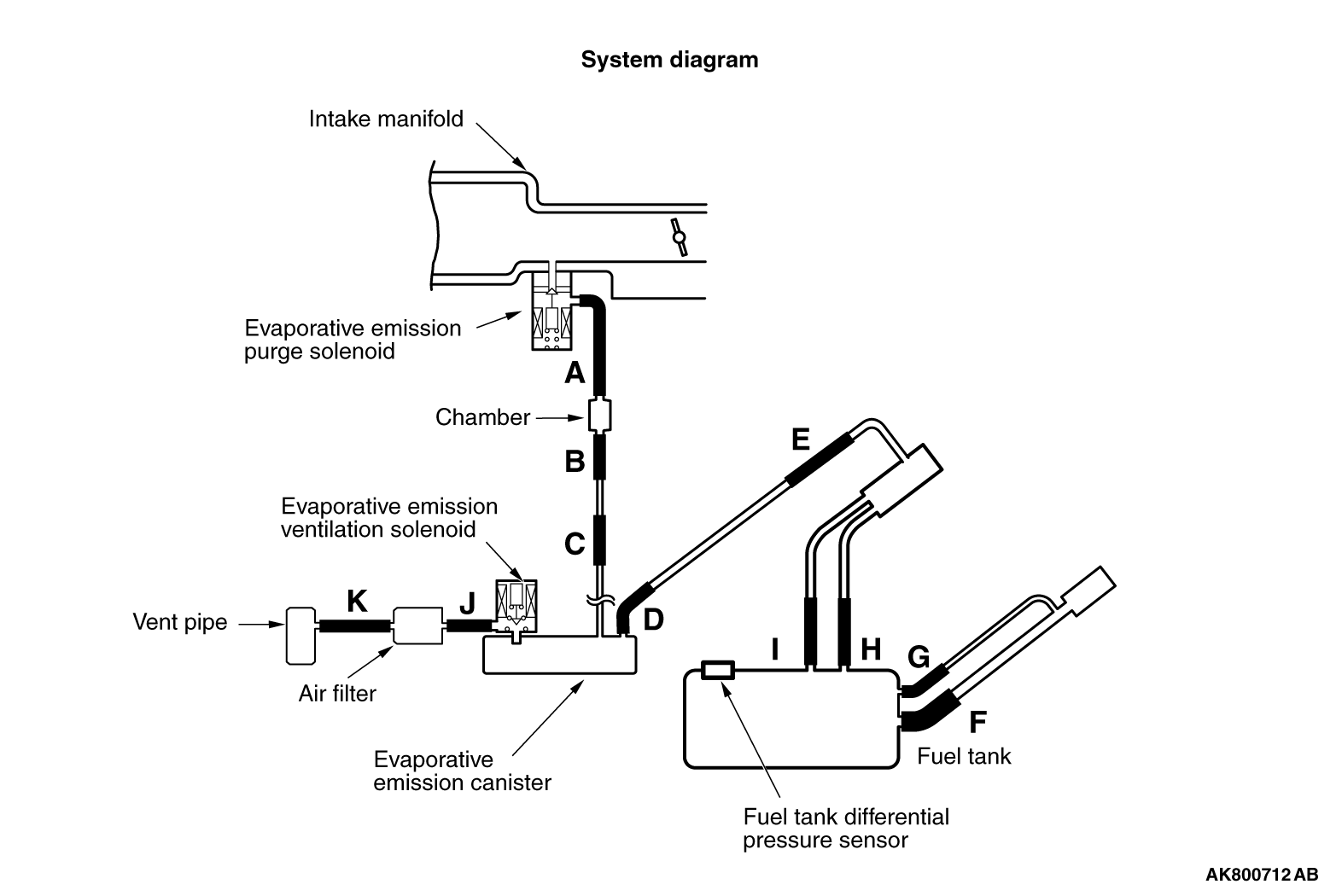
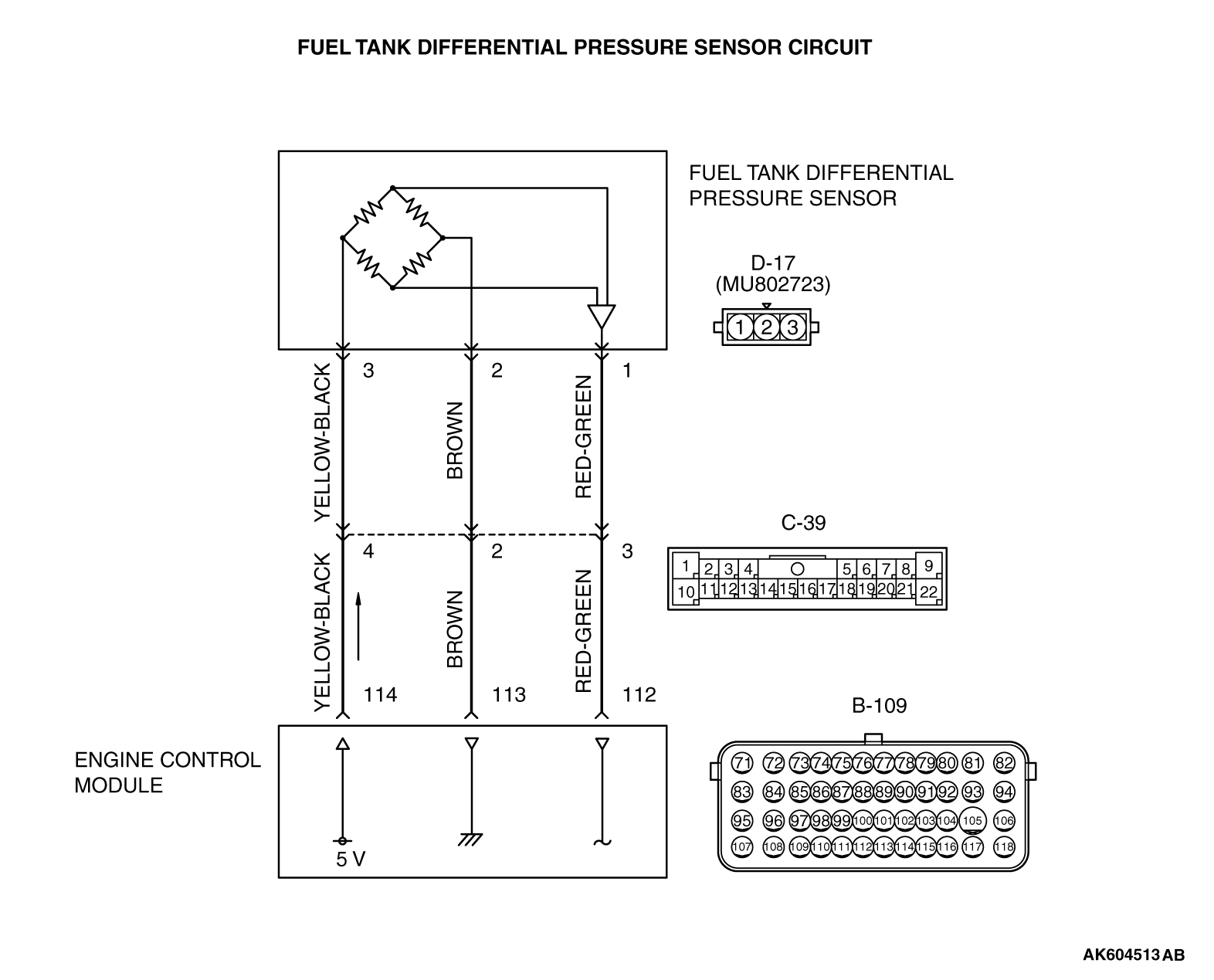
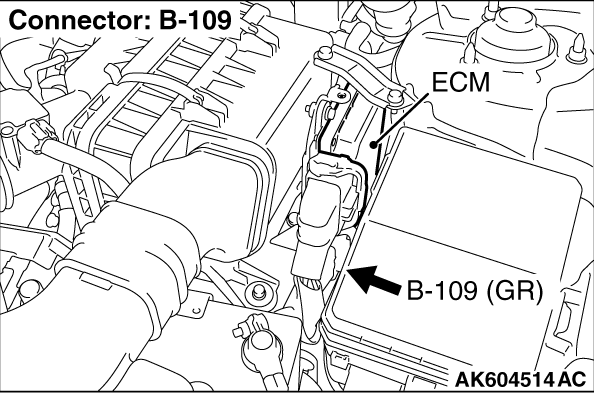
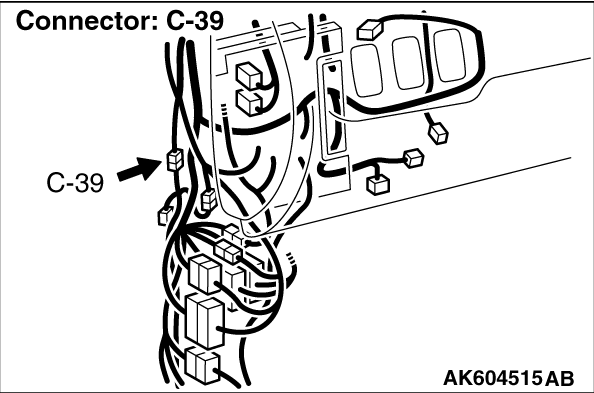
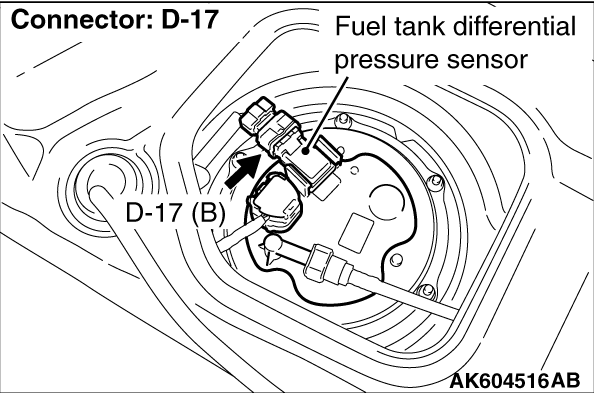
CIRCUIT OPERATION
- The ECM (terminal No. 114) supplies a 5 volts reference signal to the fuel
tank differential pressure sensor (terminal No. 3). The fuel tank differential pressure sensor
(terminal No. 2) is grounded through the ECM (terminal No. 113).
- The fuel tank differential pressure sensor (terminal No. 1) returns a voltage signal
to the ECM (terminal No. 112) that is proportional to the pressure in the fuel tank.
TECHNICAL DESCRIPTION
- The ECM monitors the fuel tank differential pressure sensor output voltage.
- The ECM determines whether the fuel tank differential pressure sensor signal voltage
is within normal operating parameters.
DESCRIPTIONS OF MONITOR METHODS
- Compare evaporative purge solenoid status with fuel tank differential pressure
sensor output voltage.
MONITOR EXECUTION
MONITOR EXECUTION CONDITIONS (OTHER MONITOR AND SENSOR)
Other Monitor (There is no temporary DTC stored in memory for the item monitored
below)
- Evaporative emission purge solenoid monitor
- Evaporative emission ventilation solenoid monitor
- Fuel temperature sensor monitor
- Fuel level sensor monitor
Sensor (The sensors below are determined to be normal)
- Mass airflow sensor
- Barometric pressure sensor
- Intake air temperature sensor
- Engine coolant temperature sensor
- Accelerator pedal position sensor
DTC SET CONDITIONS
Logic Flow Chart (Monitor Sequence)
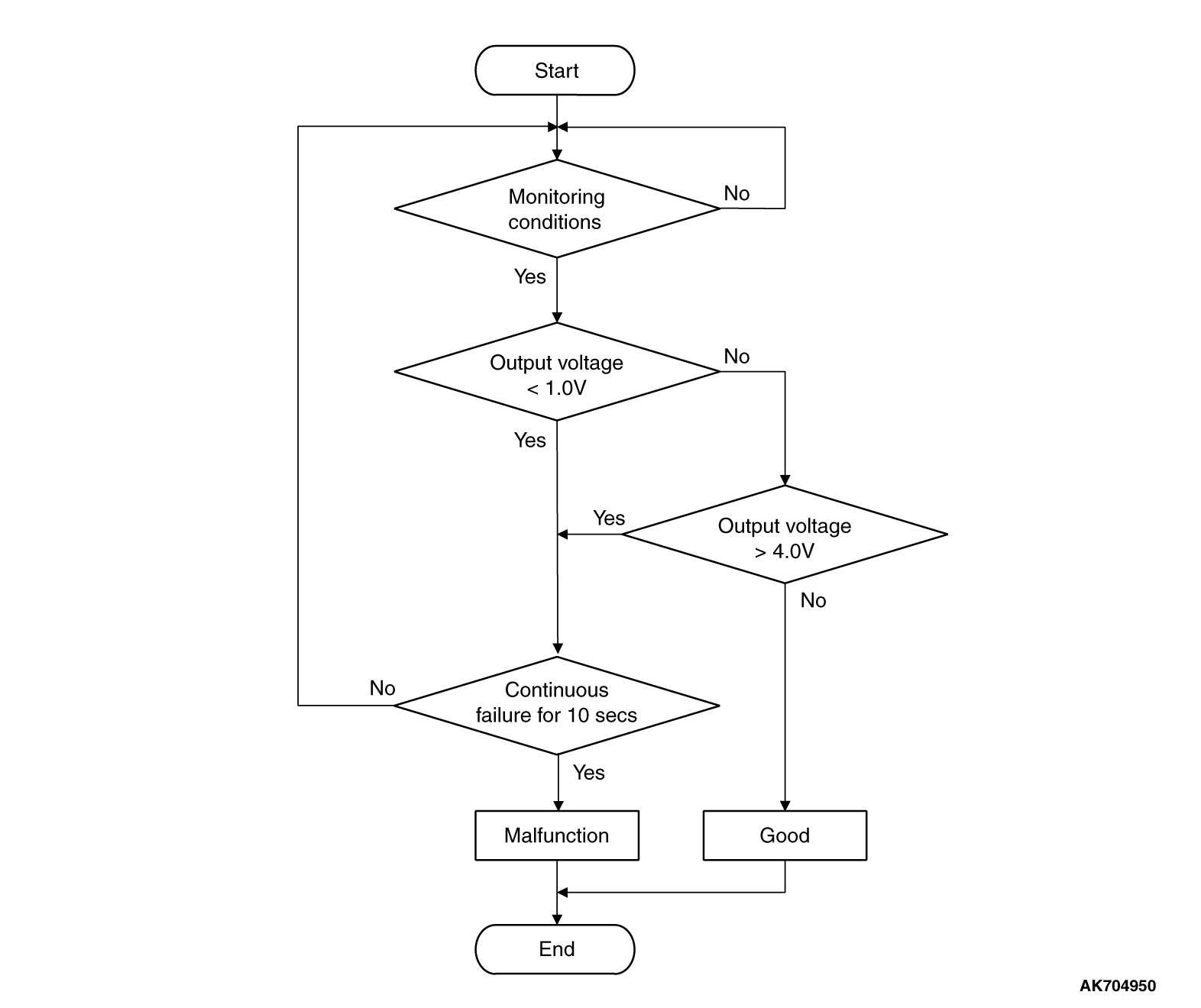
Check Conditions
- Intake air temperature is higher than 5°C (41°F).
- Engine speed is 1,594 r/min or higher.
- Volumetric efficiency is between 20 and 80 percent.
Judgement Criterion
- When the evaporative emission purge solenoid is off, the fuel differential pressure
sensor output voltage remains 1.0 volt or less for 10 seconds.
Check Conditions
- Intake air temperature is between 5°C (41°F) and 45°C
(113°F).
- Engine speed is 1,594 r/min or higher.
- Volumetric efficiency is between 20 and 80 percent.
Judgement Criterion
- When the evaporative emission purge solenoid is fully operational (100 percent ratio),
the fuel differential pressure sensor output voltage remains at 4.0 volts or more for 10 seconds.
OBD-ll DRIVE CYCLE PATTERN
Refer to Diagnostic Function - OBD-ll Drive Cycle - Pattern 5  .
.
TROUBLESHOOTING HINTS (THE MOST LIKELY CAUSES FOR THIS CODE TO BE SET ARE:)
- Fuel tank differential pressure sensor failed.
- Fuel tank differential pressure sensor circuit harness damage, or connector damage.
- ECM failed.
|
|
Required Special Tools:
- MB991958: Scan Tool (M.U.T.-III Sub Assembly)
- MB991824: V.C.I.
- MB991827: USB Cable
- MB991910: Main Harness A
|
|
|
STEP 1. Using scan tool MB991958, check data list item
52: Fuel Tank Differential Pressure Sensor.
|
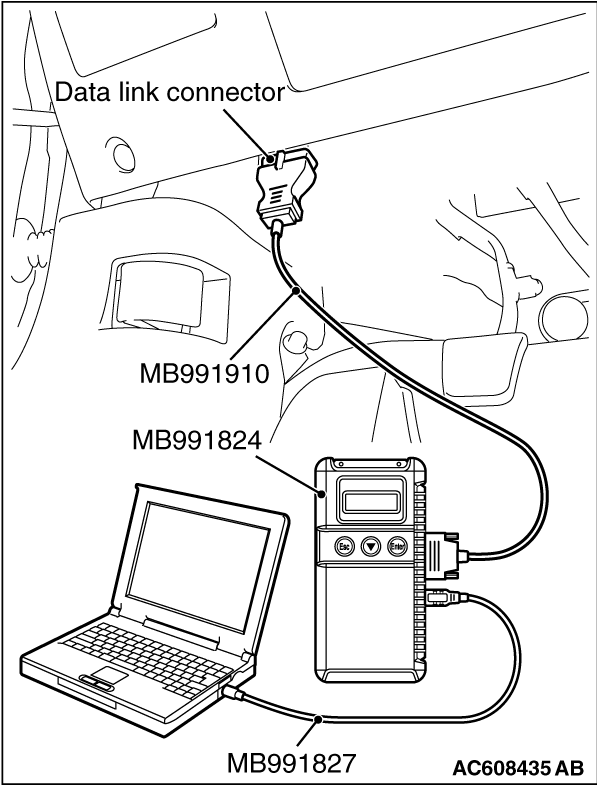
|
| caution |
To prevent damage to scan tool MB991958, always turn the ignition switch to the "LOCK"
(OFF) position before connecting or disconnecting scan tool MB991958.
|
(1)Connect scan tool MB991958 to the data link connector.
|
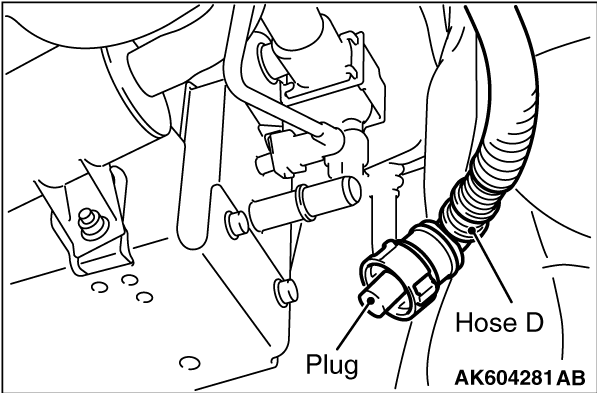
|
(2)Plug the disconnected end of hose D.
(3)Turn the ignition switch to the "ON" position.
(4)Remove the fuel cap.
(5)Set scan tool MB991958 to the data reading mode for item 52, Fuel Tank Differential
Pressure Sensor.
- Output voltage should be between 1,500 to 3,500 mV.
|
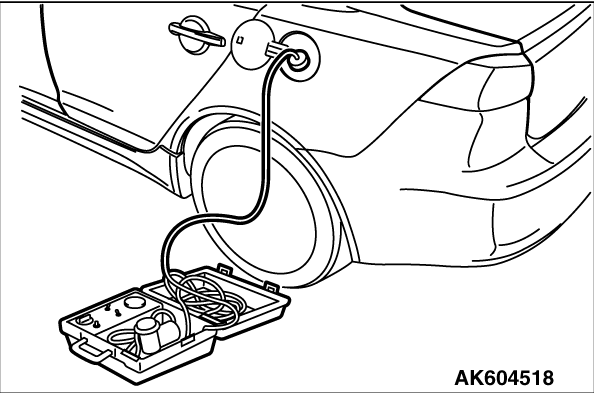
|
(6)Connect the evaporative emission system pressure pump (Miller number 6872A) to the fuel
tank filler tube by using fuel tank adapter (MLR-8382) and pressurize the fuel tank.
- The fuel tank pressure reading should increase.
(7)Turn the ignition switch to the "LOCK" (OFF) position. Then disconnect scan tool
MB991958.
(8)Remove the evaporative emission system pressure pump (Miller number 6872A) and
the fuel tank adapter (MLR-8382), and reinstall the fuel cap.
(9)Connect hose D to the evaporative emission canister.
Q.
Is the sensor operating properly?
 It can be assumed that this malfunction is intermittent. Refer to GROUP 00, How
to Use Troubleshooting / Inspection Service Points - How to Cope with Intermittent
Malfunctions It can be assumed that this malfunction is intermittent. Refer to GROUP 00, How
to Use Troubleshooting / Inspection Service Points - How to Cope with Intermittent
Malfunctions  . .
 Go to Step 2 . Go to Step 2 .
|
|
|
STEP 2. Check harness connector D-17 at fuel tank differential pressure
sensor for damage.
|
|
|
Q.
Is the harness connector in good condition?
|
|
|
 Then go to Step 3 . Then go to Step 3 .
|
|
|
|
|
|
 Repair or replace it. Refer to GROUP 00E, Harness Connector Inspection Repair or replace it. Refer to GROUP 00E, Harness Connector Inspection  .
Then go to Step 12 . .
Then go to Step 12 .
|
|
|
|
|
|
STEP 3. Measure the sensor supply voltage at fuel tank differential
pressure sensor connector D-17 by backprobing.
|
|
|
(1)Do not disconnect the connector D-17.
|
|
|
(2)Turn the ignition switch to the "ON" position.
|
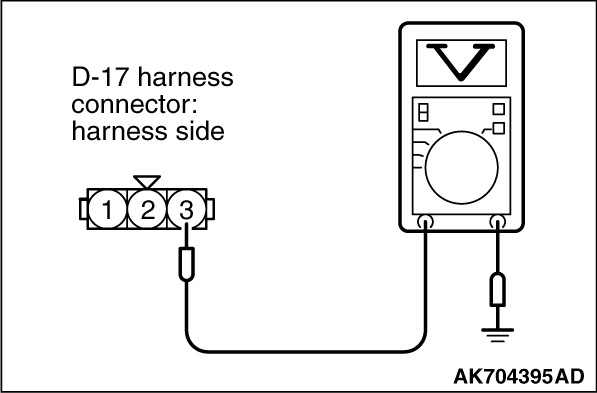
|
(3)Measure the voltage between terminal No. 3 and ground by backprobing.
- Voltage should be between 4.9 and 5.1 volts.
(4)Turn the ignition switch to the "LOCK" (OFF) position.
Q.
Is the measured voltage between 4.9 and 5.1 volts?
 Go to Step 6. Go to Step 6.
 Go to Step 4. Go to Step 4.
|
|
|
STEP 4. Check harness connector D-17 at the fuel tank differential
pressure sensor for damage.
|
|
|
Q.
Is the harness connector in good condition?
|
|
|
 Go to step 5. Go to step 5.
|
|
|
|
|
|
 Repair or replace it. Refer to GROUP 00E, Harness Connector Inspection Repair or replace it. Refer to GROUP 00E, Harness Connector Inspection  .
Then go to Step 12. .
Then go to Step 12.
|
|
|
|
|
|
STEP 5. Check for harness damage between fuel tank differential pressure
sensor connector D-17 (terminal No. 3) and ECM connector B-109 (terminal No. 114).
|
|
|
| note |
Check harness after checking intermediate connector C-39. If intermediate connector is
damaged, repair or replace it. Refer to GROUP 00E, Harness Connector Inspection  . Then
go to Step 12. . Then
go to Step 12.
|
|
|
|
Q.
Is the harness wire in good condition?
|
|
|
 Go to Step 11. Go to Step 11.
|
|
|
|
|
|
 Repair it. Then go to Step 12. Repair it. Then go to Step 12.
|
|
|
|
|
|
STEP 6. Measure the ground voltage at fuel tank differential pressure
sensor connector D-17 by backprobing.
|
|
|
(1)Do not disconnect the connector D-17.
|
|
|
(2)Turn the ignition switch to the "ON" position.
|
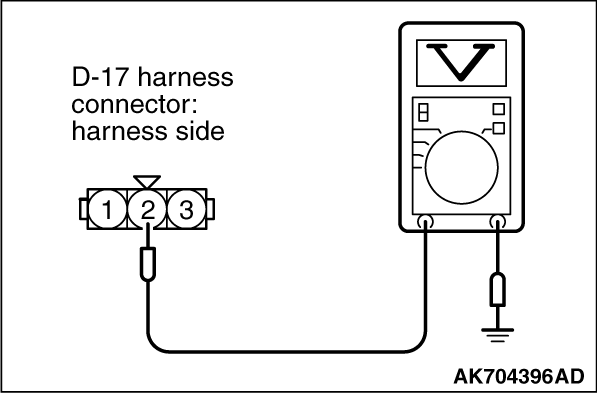
|
(3)Measure the voltage between terminal No. 2 and ground by backprobing.
- Voltage should be 0.5 volt or less.
(4)Turn the ignition switch to the "LOCK" (OFF) position.
Q.
Is the measured voltage 0.5 volt or less?
 Go to Step 9. Go to Step 9.
 Go to Step 7. Go to Step 7.
|
|
|
STEP 7. Check harness connector B-109 at the ECM for damage.
|
|
|
Q.
Is the harness connector in good condition?
|
|
|
 Go to Step 8. Go to Step 8.
|
|
|
|
|
|
 Repair or replace it. Refer to GROUP 00E, Harness Connector Inspection Repair or replace it. Refer to GROUP 00E, Harness Connector Inspection  .
Then go to Step 12. .
Then go to Step 12.
|
|
|
|
|
|
STEP 8. Check for harness damage between fuel tank differential pressure
sensor connector D-17 (terminal No. 2) and ECM connector B-109 (terminal No. 113).
|
|
|
| note |
Check harness after checking intermediate connector C-39. If intermediate connector is
damaged, repair or replace it. Refer to GROUP 00E, Harness Connector Inspection  . Then
go to Step 12. . Then
go to Step 12.
|
|
|
|
Q.
Is the harness wire in good condition?
|
|
|
 Go to Step 11. Go to Step 11.
|
|
|
|
|
|
 Repair it. Then go to Step 12. Repair it. Then go to Step 12.
|
|
|
|
|
|
STEP 9. Check harness connector B-109 at ECM for damage.
|
|
|
Q.
Is the harness connector in good condition?
|
|
|
 Go to Step 10. Go to Step 10.
|
|
|
|
|
|
 Repair or replace it. Refer to GROUP 00E, Harness Connector Inspection Repair or replace it. Refer to GROUP 00E, Harness Connector Inspection  .
Then go to Step 12. .
Then go to Step 12.
|
|
|
|
|
|
STEP 10. Check for harness damage between fuel tank differential pressure
sensor connector D-17 (terminal No. 1) and ECM connector B-109 (terminal No. 112).
|
|
|
| note |
Check harness after checking intermediate connector C-39. If intermediate connector is
damaged, repair or replace it. Refer to GROUP 00E, Harness Connector Inspection  . Then
go to Step 12. . Then
go to Step 12.
|
|
|
|
Q.
Is the harness wire in good condition?
|
|
|
 Go to Step 11. Go to Step 11.
|
|
|
|
|
|
 Repair it. Then go to Step 12. Repair it. Then go to Step 12.
|
|
|
|
|
|
STEP 11. Replace the fuel tank differential pressure sensor.
|
|
|
(1)Replace the fuel tank differential pressure sensor.
|
|
|
(2)Carry out test drive with the drive cycle pattern. Refer to Diagnostic Function.
OBD-II Drive Cycle. Pattern 5  . .
|
|
|
(3)Check the diagnostic trouble code (DTC).
|
|
|
 Replace the ECM. When the ECM is replaced, register the ID code. Refer to GROUP
42B, Diagnosis - ID Code Registration Judgment Table <Vehicles with KOS> Replace the ECM. When the ECM is replaced, register the ID code. Refer to GROUP
42B, Diagnosis - ID Code Registration Judgment Table <Vehicles with KOS>  or
GROUP 42C, Diagnosis - ID Code Registration Judgment Table <Vehicles with WCM> or
GROUP 42C, Diagnosis - ID Code Registration Judgment Table <Vehicles with WCM>  .
Then go to Step 12 . .
Then go to Step 12 .
|
|
|
|
|
|
 The inspection is complete. The inspection is complete.
|
|
|
|
|
|
STEP 12. Perform the OBD-II drive cycle.
|
|
|
(1)Carry out a test drive with the drive cycle pattern. Refer to Diagnostic Function - OBD-II
Drive Cycle - Pattern 5  . .
|
|
|
(2)Check the diagnostic trouble code (DTC).
|
|
|
 Repeat the troubleshooting. Repeat the troubleshooting.
|
|
|
|
|
|
 The procedure is complete. The procedure is complete.
|
|
|
|

![[Previous]](../../../buttons/fprev.png)
![[Next]](../../../buttons/fnext.png)






 .
.

 It can be assumed that this malfunction is intermittent. Refer to GROUP 00, How
to Use Troubleshooting / Inspection Service Points - How to Cope with Intermittent
Malfunctions
It can be assumed that this malfunction is intermittent. Refer to GROUP 00, How
to Use Troubleshooting / Inspection Service Points - How to Cope with Intermittent
Malfunctions  .
. Go to Step 2 .
Go to Step 2 . Then go to Step 3 .
Then go to Step 3 . Repair or replace it. Refer to GROUP 00E, Harness Connector Inspection
Repair or replace it. Refer to GROUP 00E, Harness Connector Inspection  .
Then go to Step 12 .
.
Then go to Step 12 .
 Go to Step 6.
Go to Step 6. Go to Step 4.
Go to Step 4. Go to step 5.
Go to step 5. Repair or replace it. Refer to GROUP 00E, Harness Connector Inspection
Repair or replace it. Refer to GROUP 00E, Harness Connector Inspection  .
Then go to Step 12.
.
Then go to Step 12. Go to Step 11.
Go to Step 11. Repair it. Then go to Step 12.
Repair it. Then go to Step 12.
 Go to Step 9.
Go to Step 9. Go to Step 7.
Go to Step 7. Go to Step 8.
Go to Step 8. Repair or replace it. Refer to GROUP 00E, Harness Connector Inspection
Repair or replace it. Refer to GROUP 00E, Harness Connector Inspection  .
Then go to Step 12.
.
Then go to Step 12. Go to Step 11.
Go to Step 11. Repair it. Then go to Step 12.
Repair it. Then go to Step 12. Go to Step 10.
Go to Step 10. Repair or replace it. Refer to GROUP 00E, Harness Connector Inspection
Repair or replace it. Refer to GROUP 00E, Harness Connector Inspection  .
Then go to Step 12.
.
Then go to Step 12. Go to Step 11.
Go to Step 11. Repair it. Then go to Step 12.
Repair it. Then go to Step 12. .
. Replace the ECM. When the ECM is replaced, register the ID code. Refer to GROUP
42B, Diagnosis - ID Code Registration Judgment Table <Vehicles with KOS>
Replace the ECM. When the ECM is replaced, register the ID code. Refer to GROUP
42B, Diagnosis - ID Code Registration Judgment Table <Vehicles with KOS>  or
GROUP 42C, Diagnosis - ID Code Registration Judgment Table <Vehicles with WCM>
or
GROUP 42C, Diagnosis - ID Code Registration Judgment Table <Vehicles with WCM>  .
Then go to Step 12 .
.
Then go to Step 12 . The inspection is complete.
The inspection is complete. .
. Repeat the troubleshooting.
Repeat the troubleshooting. The procedure is complete.
The procedure is complete.